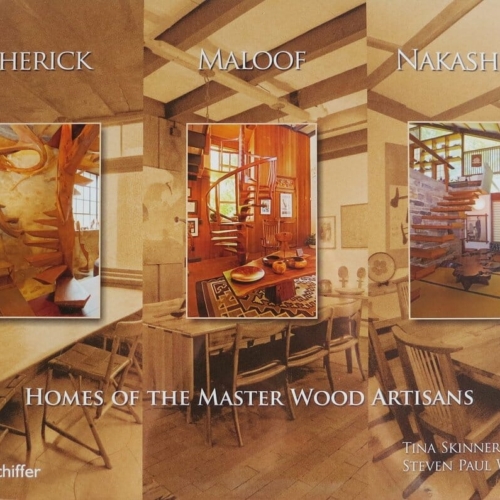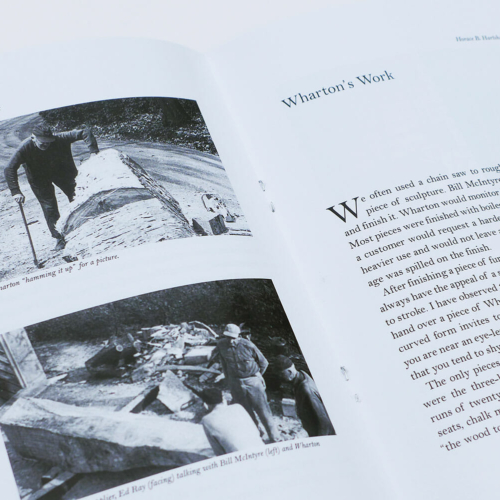-
 A rich collection of imagery explores the actual homes of three of the most esteemed wood artist/craftsmen of the modern era: Wharton Esherick, Sam Maloofi, and George Nakashima. Tour the private homes of these masters and compare their innovation and vision through the medium of their own homes, gardens, and work areas. Step into their environments, where aesthetics are most accurately realized. You’ll delight in Esherick’s humble mountaintop home where straight lines were purposefully forbidden, and Maloof’s sprawling California home that expresses his inexhaustible creativity and industriousness. Nakashima‘s home is a harmonious marriage of Japanese influences with Pennsylvania’s rich natural resources. This book is a must-have for devotees of these artists, as well as aspiring woodworkers who want tutelage from the top.
A rich collection of imagery explores the actual homes of three of the most esteemed wood artist/craftsmen of the modern era: Wharton Esherick, Sam Maloofi, and George Nakashima. Tour the private homes of these masters and compare their innovation and vision through the medium of their own homes, gardens, and work areas. Step into their environments, where aesthetics are most accurately realized. You’ll delight in Esherick’s humble mountaintop home where straight lines were purposefully forbidden, and Maloof’s sprawling California home that expresses his inexhaustible creativity and industriousness. Nakashima‘s home is a harmonious marriage of Japanese influences with Pennsylvania’s rich natural resources. This book is a must-have for devotees of these artists, as well as aspiring woodworkers who want tutelage from the top. -

 An intimate and revealing collection of photographs of astonishingly beautiful, iconic, and undiscovered mid-century interiors. Among significant mid-century interiors, none are more celebrated yet underpublished as the homes created by architects and interior designers for themselves. This collection of newly commissioned photographs presents the most compelling homes by influential mid-century designers, such as Russel Wright, George Nakashima, Harry Bertoia, Charles and Ray Eames, and Eva Zeisel, among others. Intimate as well as revelatory, Williamson’s photographs show these creative homes as they were lived in by their designers: Walter Gropius’s historic Bauhaus home in Massachusetts; Albert Frey’s floating modernist aerie on a Palm Springs rock outcropping; Wharton Esherick’s completely handmade Pennsylvania house, from the organic handcarved staircase to the iconic furniture. Personal and breathtaking by turn—these homes are exemplary studies of domestic modernism at its warmest and most creative.
An intimate and revealing collection of photographs of astonishingly beautiful, iconic, and undiscovered mid-century interiors. Among significant mid-century interiors, none are more celebrated yet underpublished as the homes created by architects and interior designers for themselves. This collection of newly commissioned photographs presents the most compelling homes by influential mid-century designers, such as Russel Wright, George Nakashima, Harry Bertoia, Charles and Ray Eames, and Eva Zeisel, among others. Intimate as well as revelatory, Williamson’s photographs show these creative homes as they were lived in by their designers: Walter Gropius’s historic Bauhaus home in Massachusetts; Albert Frey’s floating modernist aerie on a Palm Springs rock outcropping; Wharton Esherick’s completely handmade Pennsylvania house, from the organic handcarved staircase to the iconic furniture. Personal and breathtaking by turn—these homes are exemplary studies of domestic modernism at its warmest and most creative. -
 This facsimile edition of a 1922 children’s book features seventy-three dynamic and whimsical woodcut illustrations—the first woodcuts that the famed American craftsman Wharton Esherick produced. A high-quality replica authorized by the Wharton Esherick Museum, this book reveals the foundation of Esherick’s direction as an artist. Edited by Museum director Paul Eisenhauer, it also features a foreword by Museum assistant curator Laura Heemer. The illustrations frame verses that introduce children to the principles of evolution, a highly controversial topic at the time: the book was published three years before the famous Scopes “Monkey” trial of 1925 that resulted in the inclusion of the teaching of evolution in public schools. Drawn by the excitement of the controversy, Esherick threw his passion into these illustrations. Afterward he would go on to carve over 300 woodcuts, leading to decorative carving, and ultimately, to Esherick’s realization that he was a sculptor rather than a painter.
This facsimile edition of a 1922 children’s book features seventy-three dynamic and whimsical woodcut illustrations—the first woodcuts that the famed American craftsman Wharton Esherick produced. A high-quality replica authorized by the Wharton Esherick Museum, this book reveals the foundation of Esherick’s direction as an artist. Edited by Museum director Paul Eisenhauer, it also features a foreword by Museum assistant curator Laura Heemer. The illustrations frame verses that introduce children to the principles of evolution, a highly controversial topic at the time: the book was published three years before the famous Scopes “Monkey” trial of 1925 that resulted in the inclusion of the teaching of evolution in public schools. Drawn by the excitement of the controversy, Esherick threw his passion into these illustrations. Afterward he would go on to carve over 300 woodcuts, leading to decorative carving, and ultimately, to Esherick’s realization that he was a sculptor rather than a painter. -
 The Society was very pleased to have the opportunity to collaborate with Bob Bascom and the Wharton Esherick Society staff in the production of this special publication and celebrates the life of a truly remarkable woman, and shares some of the stories from her lifelong relationship with her beloved husband, their family, and the community.
The Society was very pleased to have the opportunity to collaborate with Bob Bascom and the Wharton Esherick Society staff in the production of this special publication and celebrates the life of a truly remarkable woman, and shares some of the stories from her lifelong relationship with her beloved husband, their family, and the community. -

 In 1922, Wharton Esherick showed a copy Rhymes of Early Jungle Folk, which he had illustrated with woodcut prints, to Harold Mason, owner of the Centaur Bookshop in Philadelphia. Impressed by what he saw, Mason asked Esherick to illustrate Walt Whitman’s Song of the Broad-Axe, which Mason published in a limited edition in 1924. Inspired by the woodcuts, Esherick created a hand-bound prototype book of Whitman’s poem, using prints made directly from his blocks and hand-lettering it in Esherick’s own calligraphic style. Illuminated letters were used to begin paragraphs, and spaces at the end of lines were filled with blue and yellow drawings that reflect the content of the verses. The result of this labor of love was a work of art, 17x12 inches, with pages of handmade paper, folded and uncut. This book is a reproduction of Esherick’s prototype, authorized by the Wharton Esherick Museum. Though this edition is smaller than the prototype book, the original was carefully scanned and printed to provide as true a reproduction as possible. It faithfully captures the artist’s vision and skill and, for the first time, makes this wonderful work available to the general public. It will be appreciated by all admirers of Esherick, Whitman, and lovers of fine books.
In 1922, Wharton Esherick showed a copy Rhymes of Early Jungle Folk, which he had illustrated with woodcut prints, to Harold Mason, owner of the Centaur Bookshop in Philadelphia. Impressed by what he saw, Mason asked Esherick to illustrate Walt Whitman’s Song of the Broad-Axe, which Mason published in a limited edition in 1924. Inspired by the woodcuts, Esherick created a hand-bound prototype book of Whitman’s poem, using prints made directly from his blocks and hand-lettering it in Esherick’s own calligraphic style. Illuminated letters were used to begin paragraphs, and spaces at the end of lines were filled with blue and yellow drawings that reflect the content of the verses. The result of this labor of love was a work of art, 17x12 inches, with pages of handmade paper, folded and uncut. This book is a reproduction of Esherick’s prototype, authorized by the Wharton Esherick Museum. Though this edition is smaller than the prototype book, the original was carefully scanned and printed to provide as true a reproduction as possible. It faithfully captures the artist’s vision and skill and, for the first time, makes this wonderful work available to the general public. It will be appreciated by all admirers of Esherick, Whitman, and lovers of fine books.








